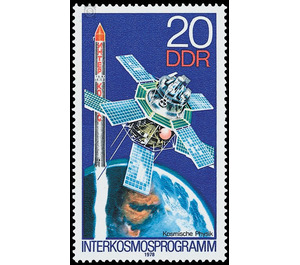Intercosmos program - Germany / German Democratic Republic 1978 - 20 Pfennig
Theme: Astronomy & Space
| Country | Germany / German Democratic Republic |
| Issue Date | 1978 |
| Face Value | 20.00 |
| Color | blue |
| Perforation | K 14 |
| Printing Type | Rotogravure 2 |
| Stamp Type | Postage stamp |
| Item Type | Stamp |
| Chronological Issue Number | 2053 |
| Chronological Chapter | GER-DDR |
| SID | 19247 |
| In 33 Wishlists | |
Intercosmology Program The Ministry of Posts and Telecommunications of the German Democratic Republic publishes three multicolored special postage stamps and a multicolored special postage stamp block for the implementation of the Intercosmology Program. Intercosmic Program In 1965, the USSR proposed to the governments of Bulgaria, Hungary, Cuba, Poland, the Mongolian People's Republic, Romania, Czechoslovakia and the GDR the unification of the scientific and technological potential of the CMEA countries in the field of cosmic sciences. She declared from the outset their willingness to provide free means of transport (rockets, satellites) and the launch and ground technology for cosmic experiments. In April 1967, the joint "Program for Exploring and Utilizing the Cosmic Space for Peaceful Purposes", which in 1970 was given the name "lnterkosmos", was adopted. Four main directions of joint research have been agreed: Cosmic Physics, Cosmic Meteorology, Cosmic Communications and Cosmic Biology and Medicine. With the orientation towards a broader application of cosmos research for the economy in 1975, the remote sensing of the earth was determined by aerocosmic means as the fifth main direction. The GDR contributions focus primarily on the areas of cosmic physics and cosmic meteorology and increasingly on the recent mainstream. Focal points are the development and construction of apparatus and equipment systems for orbital missiles and research rockets for the measurement of physical parameters in near-Earth space or for remote sounding of the earth's surface and for data transmission to Earth. So far, 17 lnterkosmos satellites have been launched in the lnterkosmos community, 10 of which also include equipment from the GDR, which is also equipped with the spacecraft "Soyuz-22", two weather satellites "Meteor", one "cosmos". Satellites, from four "vertical" geophysical rockets and 24 meteorological rockets "MR-12" and "M-100" respectively. So far 42 101 objects have been used on 42 objects. In addition, more than 150 devices have been developed and built for ground use and on-board testing. 20 Pfennig value: Satellite "Interkosmos-I" This first socialist community satellite (launched October 14, 1969) carried scientific equipment from the USSR, CSSR and GDR (on the sun-oriented platform) to study the sun's ultraviolet and X-rays Influence on the higher layers of the Earth's atmosphere. The GDR installed a Lyman Alpha photometer - a sensor for measuring solar radiation in a selected wavelength range - a transmitter 136 MHz for data transmission and a power supply block. Satellite orbit elements: the largest distance to Earth - 640 km, the greatest distance to the earth - 260 km, orbital time 93.3 min., Orbit inclination - 48.4 degrees. The two-stage standard rocket used as a carrier is about 30 m long and develops a thrust of 84 Mp.


